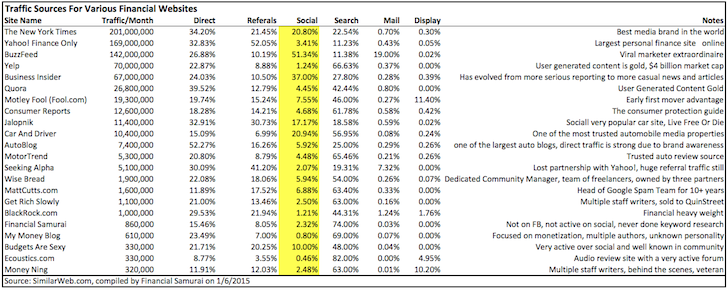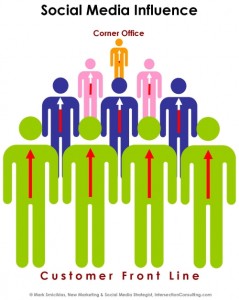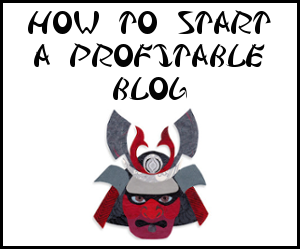As an online media consultant for several financial technology companies, I’ve been asked to think about existing traffic acquisition strategies and figure out better ways to utilize a company’s time and money to improve returns. I love analyzing data and finding solutions to increase ROI. As a problogger, leveraging my experience building Financial Samurai over the past six years to help other companies grow their brand and traffic online makes sense.
For the longest time, I’ve had a bias AGAINST social media. Who has time to tweet, like, flip, share, and do all that? Social media seriously feels like a huge time sink if you are just a one or two person show. The only platform I really use is Twitter, and even Twitter I feel is not a very good use of my time.
Look at what happens on social media:
* You open yourself up to social flaming wars
* You create stress by always feeling you have to respond to people
* The police come and arrest you once you tell everybody on Facebook you robbed a bank
* Given Facebook’s privacy settings are so confusing, Mark Zuckerberg’s sister didn’t realize the family photo she posted on her Wall was actually accessible to more people than she thought.
* You don’t get that much traffic back to your site, unless your site is really small, or all about social
There is social media overload, and I just don’t have time to run a Facebook page, Pinterest page, Twitter feed, Google+ page, and LinkedIn page to help those sites gain traffic. Instead, I’ve focused all my time just writing content on Financial Samurai and doing the basic social media publishing, but nothing more.
But some people are rockstars at social media and I wonder if it takes a certain type of personality to always be talking about yourself and your work online. I personally get sick of hearing myself speak, which is why I’m constantly looking for other viewpoints.
Let me share with you a spreadsheet I put together on various sites’ traffic figures, social percentage, and social percentage. Let’s see if we can glean any data together.
SOCIAL MEDIA’S IMPORTANT TO BLOGS AND BUSINESSES
All things being equal, we’d love to have as much social media traffic as possible. More is always better when it comes to having a website due to engagement and revenue generation. But everything is Yin Yang, and having a good social media presence requires time and resources.

Here are the key takeaways:
1) It’s interesting to see is how big social is for the venerable New York Times, and the brain deadening BuzzFeed. Both are completely opposite ends of the content spectrum, but both are excellent traffic generators. BuzzFeed raised a round of funding valuing the company at $1 billion dollars or so, and rightfully so with that type of traffic.
2) Direct traffic is something unique and owned. Direct traffic usually comes from a mention in a major media publication with no link, and more often a link in someone’s e-mail distribution list. But there is also research indicating that Direct traffic really is mostly organic search traffic. I’ve been so remiss in building an e-mail list, that I’ve only got several thousand RSS e-mail and newsletter subscribers since I just started in 2014. I kept on asking myself what am I supposed to write in my newsletter that I wouldn’t be willing to write publicly? Finally, in the beginning of 2014, I created a newsletter box and a pop up for people to subscribe. So far, nobody has revolted, so don’t be afraid to get them e-mail addresses! If Google crushes Financial Samurai, the idea is that at least I’ll still have my e-mail list.
3) Bigger, corporate sites have a higher percentage of traffic coming from social most likely due to paid social advertising. I’m well aware of how much companies spend on paid promotion due to my experience working at a financial tech company and going to a dozen marketing meet-ups and conferences discussing this topic.
4) It’s difficult for little guys without major funding to compete in social if they are relatively new because they are behind in terms of number of URLs published, and money they can spend. Even if you don’t have major funding, and just have incredible content, there’s no way someone will be able to compete against the New York Times due to their brand. Therefore, to help you succeed over the long term, you should build a brand.
5) SEO is a double-edged sword. The reason why I like a higher SEO percentage to total traffic is because SEO traffic is perpetual and takes no ongoing work. Sure, you should update posts when new facts arise, but for the most part, SEO is hands off after the initial publication.
6) If you can develop multiple income streams online, you can potentially make a full-time living as a professional blogger. SEO and social media will be a natural part of your blogging routine.
Of course, SEO is also unpredictable given all the Google algorithmic changes over the past six years I’ve been around. I’ve seen numerous sites rise and fall over the years. But the more I stick around, the more I realize that most sites who’ve been hit by a Google algorithm change did SOMETHING to warrant a downgrade in their keyword rankings.
I remember one blogger giving a testimonial for a site called Whoosh Traffic (no longer exists). I was surprised because the blogger basically outed himself on paying Whoosh Traffic to artificially help him build links! I’m not surprised that his traffic is stuck at around 65,000 all these years.
Perhaps SEO traffic as a percentage of total traffic is like a proper stocks and bond allocation for your investment portfolio. With a 50/50 allocation, you are relatively conservative and playing offense and defense. With a 100% allocation into stocks or SEO (if you could do so), you’re basically going all-in on depending on Google, Bing, Ask, and Duck Duck Go for your survival and growth. The more I think about it, the more I think a 50% SEO percentage sounds pretty healthy if you are making solid efforts on your e-mail distribution list, private newsletter, and social media channels.
COMPARING APPLES TO MANGOS
There’s a lot of apples to mangos comparisons in the chart above. I just wanted to highlight some various types of websites and their sources of traffic. Let’s say you’re feeling a little depressed that Yelp has 70 million page views and you’ve got nowhere close to that. I had this thought process when I was playing tennis with the founder the other day.
An easy way to get your head around these massive figures is to realize big media companies have many people. It takes a village to create something huge. Simply take Yelp’s 70 million monthly visitors and divide by the number of employees to make the comparison more fair. The visitor per employee is now a more reachable 23,333 a month! Meanwhile, you probably have a much greater percentage of ownership of your online media company. Beyond the first 100 employees at Yelp, the average percentage ownership is probably less than 10 basis points each.
You can also divide the site’s revenue by the number of employees to get a more apples-to-apples comparison of large sites to small sites. Some large media sites like Business Insider are loss making, so even if you make $1 in profits a year, you win!
SOCIAL MEDIA, A NECESSARY EVIL?
The time spent on social media is time spent away from generating awesome content. Here’s the proper ranking of time spent to maximize ROI:
1) Creating content
2) Managing content creators
3) Editing content
4) Testing various types of content marketing
5) Leveraging social media to boost your content, earn links, engage with your customers, and build a brand
6) Focusing on paid marketing with the highest returns if you have the resources
7) Spend time on PR, which is showing a declining return on investment since everybody is becoming a PR expert due to Social.
You can do anything you want if you have the money to spend. For most of us, we are resource constraint and want to get the most bang for our buck. Social media is important to help amplify our content. But spending a lot of our time on social media when we are resource constraint and not producing value-added content is a misallocation of resources.
STARTING A MONEY MAKING BLOG
I never thought I’d be able to quit my job in 2012 just three years after starting Financial Samurai. But by starting one financial crisis day in 2009, Financial Samurai actually makes more than my entire passive income total that took 15 years to build. If you enjoy writing, creating, connecting with people online, and enjoying more freedom, learn how you can set up a WordPress blog in 15 minutes like this one.
Leverage the 3+ billion internet users and build your brand online. There are professional bloggers now who make way more than bankers, doctors, lawyers, and entrepreneurs while having much more fun, much more freedom, and doing less work. Get started. You never know where the journey will take you!
Updated for 2017 and beyond.
Photo credit: Mark Smiciklas





I’ve prioritized content over social media for a long time mostly because I had limited hours and the various platforms were distracting me from writing and other work. Now that I have more flexibility in my schedule, I need to start getting more active in social sharing and networking. I gotta get back into a rhythm with it and get all my apps updated on my phone. I was using Buffer for a long time until the app choked on my phone and I never bothered to reinstall it lol.
I think social media cannot be ignored. You may not have to make it a priority, but if you put in some effort it can help you out. I think its a classic you get what you put in to it type of scenario. Do you have to post on 25+ sites? No.
Here’s the thing. If you spend all your time on Facebook, you drive lots of traffic to Facebook. Instead, best to spend your time interacting with readers on your site. All you need is a Facebook Like button on your social plugins to get it shared on FB.
I just started focusing on social media again and it has some definite benefits. First, it draws some more eyeballs to my site that wouldn’t have otherwise landed there. Second, it allows me to meet with like-minded people and partner with them for future projects. And finally, if I am able to build it up large enough, my social media business by itself could actually generate some income. I have a long way to go here, but it’s a possibility.
Reaching out to people you couldn’t have connected with is definitely a benefit, especially if you find your existing community/userbase/clients set, and you want to expand.
I definitely wouldn’t count on trying to make money through social though! Perhaps if you worked at Twitter or FB yes.
I agree with you that Social Media for the most part is not very productive. It’s a time sink, and beneficial for Social Media companies and their profits, but not great for business. Lowest ROI.
Social media definitely has its place, but it’s important to put it in its place. If not…. Be prepared to waste a ton of time.
Social media is a growing source of traffic for me but I agree it can be a big time consumer. I’m participating in a TweetChat on Millennial Finance at the end of this month and will be a great opportunity to interact in a different forum. As far as other social media channels it’s been hit or miss as far as generating consistent traffic and it depends on what readers are looking for.
I fully agree that social media is time consuming and that creating valuable content is more important. However, it can help with future organic traffic thanks to the number of links generated.
Social Media is always last on my list and tends to get very little attention. And like you I have only spent any time on Twitter. Otherwise I just have my post auto published to Facebook, Twitter, and Google+.
I have read about people that have used paid promotion on Facebook to acquire email subscribers for very cheap. But I think you need to have a good squeeze page set up with a good lead magnet.
But this definitely has some interest to me. Especially as my site has begun making some ad money. I would not be opposed to reinvest it back into growing my email list and thus another traffic source.
Good article.